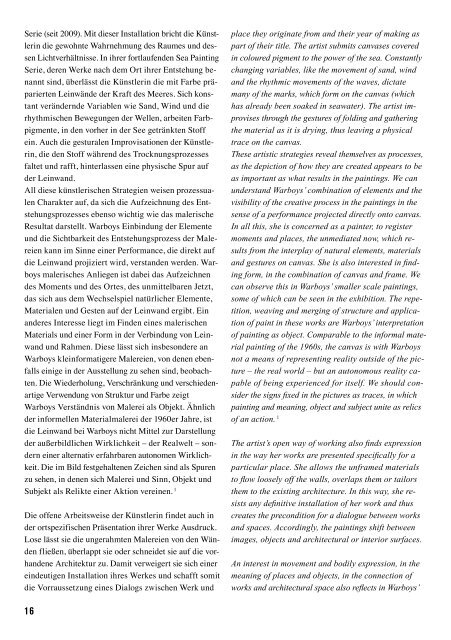PDF download 954 KB - Thomas Kratz
PDF download 954 KB - Thomas Kratz
PDF download 954 KB - Thomas Kratz
You also want an ePaper? Increase the reach of your titles
YUMPU automatically turns print PDFs into web optimized ePapers that Google loves.
Serie (seit 2009). Mit dieser Installation bricht die Künstlerindie gewohnte Wahrnehmung des Raumes und dessenLichtverhältnisse. In ihrer fortlaufenden Sea PaintingSerie, deren Werke nach dem Ort ihrer Entstehung benanntsind, überlässt die Künstlerin die mit Farbe präpariertenLeinwände der Kraft des Meeres. Sich konstantverändernde Variablen wie Sand, Wind und dierhythmischen Bewegungen der Wellen, arbeiten Farbpigmente,in den vorher in der See getränkten Stoffein. Auch die gesturalen Improvisationen der Künstlerin,die den Stoff während des Trocknungsprozessesfaltet und rafft, hinterlassen eine physische Spur aufder Leinwand.All diese künstlerischen Strategien weisen prozessualenCharakter auf, da sich die Aufzeichnung des Entstehungsprozessesebenso wichtig wie das malerischeResultat darstellt. Warboys Einbindung der Elementeund die Sichtbarkeit des Entstehungsprozess der Malereienkann im Sinne einer Performance, die direkt aufdie Leinwand projiziert wird, verstanden werden. Warboysmalerisches Anliegen ist dabei das Aufzeichnendes Moments und des Ortes, des unmittelbaren Jetzt,das sich aus dem Wechselspiel natürlicher Elemente,Materialen und Gesten auf der Leinwand ergibt. Einanderes Interesse liegt im Finden eines malerischenMaterials und einer Form in der Verbindung von Leinwandund Rahmen. Diese lässt sich insbesondere anWarboys kleinformatigere Malereien, von denen ebenfallseinige in der Ausstellung zu sehen sind, beobachten.Die Wiederholung, Verschränkung und verschiedenartigeVerwendung von Struktur und Farbe zeigtWarboys Verständnis von Malerei als Objekt. Ähnlichder informellen Materialmalerei der 1960er Jahre, istdie Leinwand bei Warboys nicht Mittel zur Darstellungder außerbildlichen Wirklichkeit – der Realwelt – sonderneiner alternativ erfahrbaren autonomen Wirklichkeit.Die im Bild festgehaltenen Zeichen sind als Spurenzu sehen, in denen sich Malerei und Sinn, Objekt undSubjekt als Relikte einer Aktion vereinen. 1Die offene Arbeitsweise der Künstlerin findet auch inder ortspezifischen Präsentation ihrer Werke Ausdruck.Lose lässt sie die ungerahmten Malereien von den Wändenfließen, überlappt sie oder schneidet sie auf die vorhandeneArchitektur zu. Damit verweigert sie sich einereindeutigen Installation ihres Werkes und schafft somitdie Vorraussetzung eines Dialogs zwischen Werk und16place they originate from and their year of making aspart of their title. The artist submits canvases coveredin coloured pigment to the power of the sea. Constantlychanging variables, like the movement of sand, windand the rhythmic movements of the waves, dictatemany of the marks, which form on the canvas (whichhas already been soaked in seawater). The artist improvisesthrough the gestures of folding and gatheringthe material as it is drying, thus leaving a physicaltrace on the canvas.These artistic strategies reveal themselves as processes,as the depiction of how they are created appears to beas important as what results in the paintings. We canunderstand Warboys’ combination of elements and thevisibility of the creative process in the paintings in thesense of a performance projected directly onto canvas.In all this, she is concerned as a painter, to registermoments and places, the unmediated now, which resultsfrom the interplay of natural elements, materialsand gestures on canvas. She is also interested in findingform, in the combination of canvas and frame. Wecan observe this in Warboys’ smaller scale paintings,some of which can be seen in the exhibition. The repetition,weaving and merging of structure and applicationof paint in these works are Warboys’ interpretationof painting as object. Comparable to the informal materialpainting of the 1960s, the canvas is with Warboysnot a means of representing reality outside of the picture– the real world – but an autonomous reality capableof being experienced for itself. We should considerthe signs fixed in the pictures as traces, in whichpainting and meaning, object and subject unite as relicsof an action. 1The artist’s open way of working also finds expressionin the way her works are presented specifically for aparticular place. She allows the unframed materialsto flow loosely off the walls, overlaps them or tailorsthem to the existing architecture. In this way, she resistsany definitive installation of her work and thuscreates the precondition for a dialogue between worksand spaces. Accordingly, the paintings shift betweenimages, objects and architectural or interior surfaces.An interest in movement and bodily expression, in themeaning of places and objects, in the connection ofworks and architectural space also reflects in Warboys’Raum. So changieren die Malereien zwischen Bild, Objektund räumlicher Oberfläche.Das Interesse an Bewegung und körperlichem Ausdruck,die Bedeutung von Orten und Objekten, die Verbindungvon Werk und architektonischem Raum spiegelt sichauch in Warboys Arbeitsweise mit dem Medium Filmwieder. Graduell offenbart sich das Narrativ im Zusammenspielvon spezifischen Orten und Objekten, Gestenund Metaphern und mit der Hilfe von Figuren aus Literaturund Geschichte. Jessica Warboys Film-Arbeitenfinden ihre Inspiration oftmals in persönlichen oder kollektivenErinnerungen, seien sie historisch, mythischoder fiktional. So greift sie Erinnerungen an bekanntewie unbekannte, weibliche Persönlichkeiten wie beispielsweiseJeanne d’Arc 2 oder Marie de France 3 aufund überführt deren symbolische Bedeutung ins Heute.Auf abstrakte, non-lineare Weise erzählt Warboys die Geschichtendieser Frauen, befragt die Vergangenheit unddie daran gebundene Konstruktion von Geschicht(en) undJESSICA WARBOYSThunderclap, 2012Karlsaue Park, KasselPerformance in Zusammen arbeit mit Morten Norbye HalvorsenCourtesy die Künstlerin und Gaudel de Stampa, ParisIn Auftrag gegeben und produziert von dOCUMENTA (13)17way of working with the medium of film. The narrativereveals itself gradually in the interplay of specific placesand objects, gestures and metaphors, with the helpof figures from literature and history. Jessica Warboys’works in film often find their inspiration in personal orcollective memories, be they historical, mythical or fictional.Accordingly, she takes up memories associatedwith female personalities, both well known and unknown,for example, Joan of Arc 2 or Marie de France 3 ,and transfers their symbolic significance into the presentday. Warboys tells the stories of these women inan abstract, non-linear manner, enquires into theirpast and the construction of story/ies linked to it andconnects them with the here-and-now of her concreteartistic work.In this way, Jessica Warboys worked at the Smith-Lesouêf library on the outskirts of Paris in 2010. Thislibrary was founded by two sisters, Madeleine Smith-Champion and Jeanne Smith, in the early 1920s.


